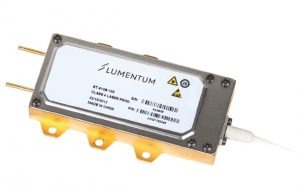ST-915B Lumentum (JDSU) 140 W Fiber-Coupled Diode Pump Laser Module
The ST Series fiber-coupled diode pump module offers up to 140 W output through a 106.5 μm fiber. It uses a high-power proprietary chip optimized for reliability at high peak power. The ST Series leverages a long history of fiber-coupled packages such as the L4, incorporating a highly-reliable design in a scalable commercial product.
The multimode pump module offers high brightness, small size, and simplified thermal management. Similar to the Lumentum L4 package, the diodes operate independently as distributed heat sources, allowing air- or water-cooled architectures with predictable high reliability.
The ST Series is a unique solution for the fiber-coupled pump-laser market, offering powerful technical attributes in a cost-effective package.
Key Features
- 140 W output power into 106.5 μm aperture

- High reliability
- 1060 nm feedback protection
- 0.22 numerical aperture (NA) fiber
- Isolated electrical contacts
Applications
- Fiber laser pumping
- Material processing
- Graphic arts
Specifications
| Parameter | Symbol | Minimum | Typical | Maximum |
| Laser Characteristics at 140 W Output Power | ||||
| Maximum operating current set point (BOL) | Iop, BOL | . | . | 13.0 A |
| Maximum operating voltage at I = 13 A (BOL) | Vop, max | . | . | 25.0 V |
| Electrical-to-optical conversion efficiency at Iop,
BOL set point |
PCE (140 W)
PCE (120 W) |
42%
36% |
48%
41% |
.
. |
| Wavelength range at Iop (98% of power within band) | λ
λ |
908 nm
928 nm |
.
. |
928 nm
950 nm |
| Wavelength shift with temperature | . | 0.3 nm/°C | . | |
| Back reflection isolation 1060–1100nm | 30 dB | . | . | |
| Light within 0.15 NA | . | 95% | . | |
| Fiber Characteristics | ||||
| Fiber core diameter (Nufern P/N FUD-4130) | dc | 105 μm | 106.5 μm | 108 μm |
| Fiber numerical aperture | NA | 0.20 | 0.22 | 0.24 |
| Fiber cladding diameter | dcl | 124 μm | 125 μm | 126 μm |
| Fiber buffer diameter | db | 230 μm | 245 μm | 260 μm |
| Fiber loose tubing diameter | dj | 0.75 mm | . | 1.05 mm |
| Total fiber length | Lf | 1.2 m | . | 2.0 m |
| Fiber loose tubing length | Lt | 0.7 m | . | 0.9 m |
| Fiber bend radius | 30 mm | . | . | |
| Fiber termination | . | None | . | |
| Fiber axial pull force, 15 sec | . | . | 5 N | |
| Fiber side pull force, 15 sec | . | . | 2.5 N | |
- All electrical and optical performance data referenced at 35°C (case temperature) and Iop beginning of life (BOL), unless specified.
Note: cold plate typically needs to be chilled to 25°C–30°C to maintain 35°C pump case temperature.
Environmental Requirements
| Parameter | Minimum | Maximum | Notes |
| Case operating temperature (base of laser housing) | 10°C | 50°C | Mounting feet can be used to approximate base temperature. |
| Storage and transportation temperature (non-operating) | .30°C | 75°C | Non-condensing under operation and storage. |
| Electrostatic discharge (ESD) | . | 500 V | HBM |
| Maximum voltage between any pin and package | . | 75 V | |
| RoHS 6/6 | Compliant |
Operating Considerations
Operating the diode laser outside at maximum ratings may cause device failure or a safety hazard. Power supplies used with the component must be employed so that the maximum peak optical power cannot be exceeded. CW diode lasers may be damaged by excessive drive current or switching transients. When power supplies are used, the diode laser should be connected with the main power on and the output voltage at zero. The current should be increased slowly while the diode laser output power and the drive current are monitored.
Device degradation accelerates with increased temperature, and thus the case temperature should be minimized and the unit operated in a non-condensing atmosphere.
A proper heatsink for the diode laser on a thermal radiator will greatly enhance laser life. Refer to the product application note for more information regarding heat sinking and mounting the product.
Electrostatic Discharge (ESD) Protection
ESD is the primary cause of unexpected diode-laser failure. Take extreme precaution to prevent ESD. Use wrist straps, grounded work surfaces, and rigorous antistatic techniques when handling diode lasers.
Laser Safety
DANGER
Invisible laser radiation. The laser beam emitted from this diode laser is invisible and can cause serious injury. Avoid looking directly into the diode laser or the collimated laser beam along its optical axis when the device is in operation. Avoid reflected or scatter radiation. Use protective eyewear properly selected for the laser beam wavelength and maximum power.
Viewing the laser output with certain optical instruments
(e.g., eye loupes, magnifiers, and microscopes) will increase eye hazards.

